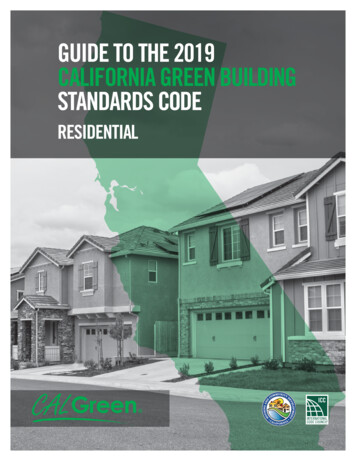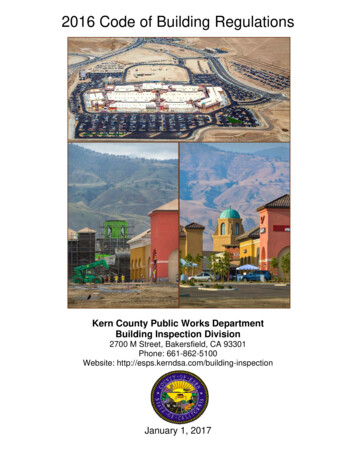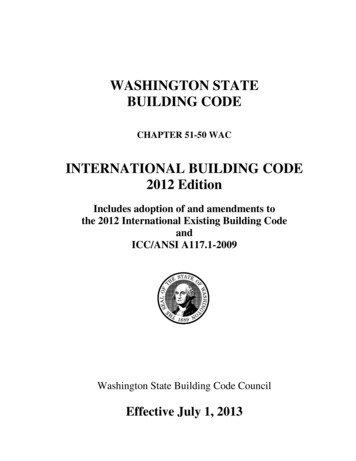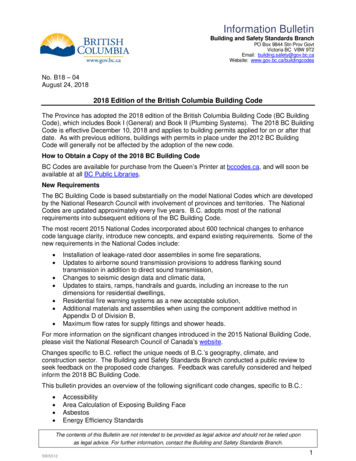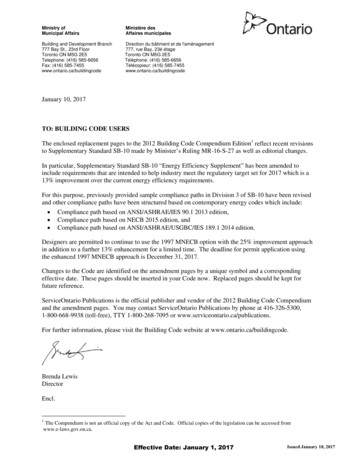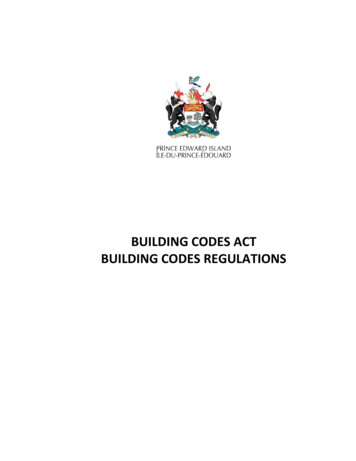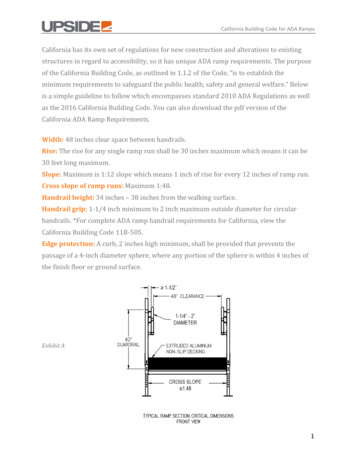
Transcription
California Building Code for ADA RampsCalifornia has its own set of regulations for new construction and alterations to existingstructures in regard to accessibility, so it has unique ADA ramp requirements. The purposeof the California Building Code, as outlined in 1.1.2 of the Code, “is to establish theminimum requirements to safeguard the public health, safety and general welfare.” Belowis a simple guideline to follow which encompasses standard 2010 ADA Regulations as wellas the 2016 California Building Code. You can also download the pdf version of theCalifornia ADA Ramp Requirements.Width: 48 inches clear space between handrails.Rise: The rise for any single ramp run shall be 30 inches maximum which means it can be30 feet long maximum.Slope: Maximum is 1:12 slope which means 1 inch of rise for every 12 inches of ramp run.Cross slope of ramp runs: Maximum 1:48.Handrail height: 34 inches – 38 inches from the walking surface.Handrail grip: 1-1/4 inch minimum to 2 inch maximum outside diameter for circularhandrails. *For complete ADA ramp handrail requirements for California, view theCalifornia Building Code 11B-505.Edge protection: A curb, 2 inches high minimum, shall be provided that prevents thepassage of a 4-inch diameter sphere, where any portion of the sphere is within 4 inches ofthe finish floor or ground surface.Exhibit A1
California Building Code for ADA RampsExhibit BLanding width: The landing must be at least as wide as the widest ramp run leading to thelanding with a minimum dimension of 48 inches between the handrails. NOTE: Landings atthe top of the ramp must be at least 60 inches wide in the direction of travel.Landing length: Each landing must be at least 60 inches clear length. NOTE: Landings atthe bottom of a ramp must extend 72 inches in the direction of travel past the edge of theramp.Landing at a change in direction: 72 inches x 60 inches minimum in the direction ofDOWNWARD travel from the upper ramp run.Exhibit C2
California Building Code for ADA RampsExhibit DExhibit ELandings with doors or gates: All ADA ramp landings with manual, swinging doors orgates in California must comply with maneuvering clearance regulations as well asminimum platform width regulations.The California Building Code states, “doors in any position shall not reduce the minimumdimension of the landing to less than 42” and shall not reduce the required width by morethan 3 inches when fully open.” (11B-405.7.5) See Exhibit F below.3
California Building Code for ADA RampsExhibit FRecommended Platform Sizes: Below are the minimum platform sizes to accommodateboth ADA ramp requirements for California and California Building Code ramprequirements involving maneuvering clearances and minimum landing dimensions:TYPE OF USEApproachDoor orDirectionGate SideMINIMUM MANEUVERING CLEARANCELength (in direction of travel)Width (in directionParallel toof travel) 3Doorway (beyond latchside unless noted)78″ (42″ min. door width 1)78” (42″ min. door42”width1)60″60″0” 3138″ (42″ min. door width 1 12″ 78″ (42″ min. door42″for required ramp rontHingesidePushPullHingesideLatch sidePushPull78″ (42″ min. door width 1)Latch sidePush60″78” (42″ min. 61 . The ADA states that doors should be at least 36″ wide.2 . Add 12″ if the door is equipped with both a latch and a closer.3 . Platform must be at least as wide as the widest ramp run that leads to it.4
California Building Code for ADA RampsExhibit G5
California Building Code for ADA RampsSOURCES:2010 ADA Regulations for Maneuvering Clearances (404.2.4)2016 California Building Code Chapter 11B for Maneuvering Clearances (11B-404.2.4)2016 California Building Code Chapter 11B for Ramp Landings (11B-405.7)2016 California Building Code Chapter 11B for Doorways (11B-405.7.5)6
California Building Code for ADA Ramps 2 Exhibit B Landing width: The landing must be at least as wide as the widest ramp run leading to the landing with a minimum dimension of 48 inches between the handrails. NOTE: Landings at the top of the ramp mu

